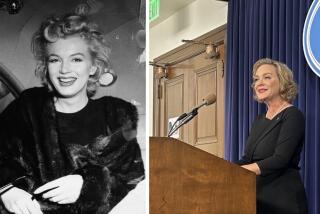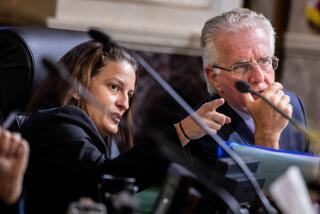Castle Builder’s Spirit Stays Alive as Planners OK Resort in Ramona
- Share via
The spirit of Amy Strong, a turn-of-the-century seamstress who built a 27-room castle at the foot of Mt. Woodson, remained alive as county planning commissioners last week approved a residential resort project on the rural Ramona acreage she once owned.
The centerpiece of the proposed development will be the stone-and-adobe residence that Strong, who died in 1950 at the age of 89, built with her earnings as a dress designer for the rich families of San Diego and Coronado and which was first listed in the National Register of Historic Places in 1978.
After more than two hours of debate over modern-day problems of sewage and traffic that the new development posed, commissioners voted unanimously to approve the Castle Highlands project. They cited the developers’ sensitivity to the historic building and to the concerns of Ramona citizens who had vehemently protested earlier proposals to develop the 379-acre estate surrounding the castle.
Richard Bottomley, former Coronado mayor and present owner of the property, said that earlier opposition from Ramona residents came from “lack of understanding about what we were proposing to do” and the memory of bitter fights over previous development proposals for the castle and its domains.
Castle Due for Renovation
Bottomley, president of the PRW Co., plans to construct 190 homes, a 100-room inn, a golf course, riding stables and trails, tennis courts and a shopping center on the property along California 67 at Archie Moore Road. The 12,000-square-foot castle will be renovated to become a clubhouse complete with a restaurant, lounge, banquet area and meeting rooms, according to the proposal, which must still gain the approval of the county Board of Supervisors.
Brian Mooney, a project consultant, said opposition from Ramona residents melted when they realized that the development would bring sales and hotel-motel tax revenues to their community and that the castle Amy Strong built would remain virtually untouched.
Previous owners of the rolling oak-studded property had proposed it as a religious retreat including a mobile home village, and as a health spa. The retreat failed because of community opposition to mobile homes on the historic site. The health spa, also opposed by the community, folded because of financial troubles.
Guy Woodward, curator of the Ramona Historical Society museum and who has been an active participant in community historical matters for decades, gave his stamp of approval to the Bottomley project.
“This is the only company that’s been in here--and I’ve dealt with every one of ‘em for the last 30 years--that has given any thought to what the community wants,” Woodward said. “I’m sure glad they got hold of the property.”
Amy Strong and her friend, San Diego architect Emmor Weaver, began work on the castle in 1916, spending $50,000 by the time the castle was completed in 1921. The multistoried mansion has rock walls ranging in thickness from four to seven feet, massive flagstone flooring, 16-foot ceilings in the 72-foot-long living room, a high-arched entry door and decorations from all cultures throughout the building. A replica of a Dutch windmill stands near the castle--one of the many ideas that Strong brought back from Europe, which she visited annually to pick up dress material and fashion hints for San Diego’s elite.
Preservation of the historic castle weighed heavily in Friday’s commission vote to override protests from Poway city officials and approve the development. The chief concern of Poway is that the residential development would add to the crush of rush-hour traffic on Poway Road and California 67.
Ruth Meyer, a Ramona historian and member of the Ramona Community Planning Group who voted against approval of the project, was not present at the county hearing to voice her objections.
No Protection
Although the castle is listed on the National Register as a historic building, the designation gives it no protection from demolition or remodeling, according to Ron Buckley, consultant to the San Diego City Historic Site Board.
However, Ron May, consultant to the newly-formed county historical site group, said that the structure is “a certain candidate” for county historical designation and protection after the county Board of Supervisors adopts historic site overlay zoning ordinances later this year.
More to Read
Sign up for Essential California
The most important California stories and recommendations in your inbox every morning.
You may occasionally receive promotional content from the Los Angeles Times.






